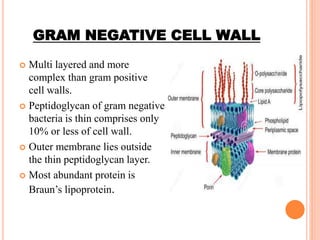Select the Organisms That Typically Have Cell Walls.
Prokaryotes are living organisms that have cells that have no membrane-bound organelles. A sponge can drop a piece of itself on to the floor of the ocean and the little piece then grows into a new individual.

Cell Wall Structures Of Gram Positive And Gram Negative Bacteria And Download Scientific Diagram
The organisms which completely lack a cell wall and can live without oxygen are.

. In contrast few other eukaryotes or. - All cells originate from preexisting cells. Compare the shapes of the organisms that did and did not have cell walls.
What effect does the cell wall have. Cell walls are present in most prokaryotes a single-celled organisms except mollicute bacteria in algae fungi and eukaryotes including plants but are absent in animals. - All cells have nuclei.
Plant cell walls are composed of cellulose. Nutrients are acquired by photosynthesis ingestion of other organisms or. They are small although many are big enough to be recognized in a dissecting microscope or even with a magnifying glass.
Three types of organisms that are made of. They have a peptidoglycan cell wall. The correct answer is E They lack a plasma membrane.
The plant cell wall is composed of cellulose. Fungi plants and algae typically have cell walls. Mucor is a fungi.
They have organelles including a nucleus and may have chloroplasts so some will be green and others wont be. - All organisms are made of one or more cells. Whether bacterium or blue whale every organism is made of _____ - cells.
Protozoa and animals do not have cell walls. They use flagella for locomotion. Most prokaryotic organisms plants and fungi have cell walls.
The cell wall serves many functions such as protecting the cell from external threats assisting in the transport of materials into the cell and giving the cell shape and structure. Animals however do not have cell walls. Check All That Apply 016 points Animals eBook Fungi References Protozoa Algae Plants.
Select the three components of the cell theory devised in the mid-1800s. A cell wall is present in organisms in the kingdoms Archaebacteria Eubacteria Protista Fungi and Plantae bacteria protists fungi and plants. Prokaryotes and eukaryotes those without a separately defined nucleus and those with a nucleus protected by a cellular membrane.
The prokaryotic cell is much smaller than the eukaryotic cell and it is less complex. The thin peptidoglycan layer next to the plasma membrane and bounded on either side by the periplasmic space usually constitutes only 5 to 10 of the wall weight. The cell is the smallest living organism that contains all the features of life and most all life on the planet begins as a single-cell organism.
The plant cell wall consists of three layers. Algal cell walls are quite varied composed of cellulose pectin mannans or minerals. Cellulose is a structural carbohydrate and is considered a complex sugar because it is used in both protection and structure.
9 Select all of the organisms that typically have cell walls. The organisms which completely lack a cell wall and can live without oxygen are. 100 1 rating Protozoa and animals do not have cell w.
Cell plate-1 cell wall-2 cell membrane-3 Name 3 types of organisms that are made of plant cells. Previous question Next question. Prokaryotes are unicellular organisms without a true nucleus.
They are very small in size from 01 to 50 µm. Animals are the only organisms that do not have a cell wall. The cell wall helps to maintain the shape of the cell and prevents dehydration.
View the full answer. Two types of single-celled organisms currently exist. Hence its cells are surrounded by a cell wall.
A cell wall is a structural layer surrounding the outer membrane of some types of cells. Get the answers you need now. Most are multicellular eukaryotic possess cell walls do not perform photosynthesis non- mobile representative organisms include mushrooms and mold.
- The cell is the fundamental unit of all life. For more about the classification of organisms see the chapter Basics of Biology In fact the cell wall is one of the features of. Organisms with cell wall typically have certain.
What groups of organisms have a cell wall. Cell wall is found in prokaryotes like bacteria and cyanobacteria plant cells and fungi. Liaeddy13 liaeddy13 11272018 Biology.
Each layer has its own unique structure and function. Cell wall is absent in animal cells. Cell wall in fungi is made up of fungal chitin and fungal cellulose.
The types of organisms that house cell walls are plants bacteria algae fungi and pretty much any type of organism. Correctly identify the kingdom whose members exhibit these traits. Fungal cell walls are composed of chitin.
It is evident that gram-negative cell walls are much more complex than gram-positive walls. All prokaryotic cells contain a plasma membrane a cell wall and ribosomes scattered in the cytoplasm. There is usually no cell wall although some forms may have a cell wall.
This facilitates the diffusion of ions and molecules to different parts of the cell. A heterotrophic multicellular organism that does not have cell walls is called an _____. Select all of the organisms that typically have cell walls.

Cell Walls Of Prokaryotes Boundless Microbiology

Cell Wall Structure And Function

Simplified Model Of Plant Cell Wall Structure A The Structure Download Scientific Diagram
0 Response to "Select the Organisms That Typically Have Cell Walls."
Post a Comment